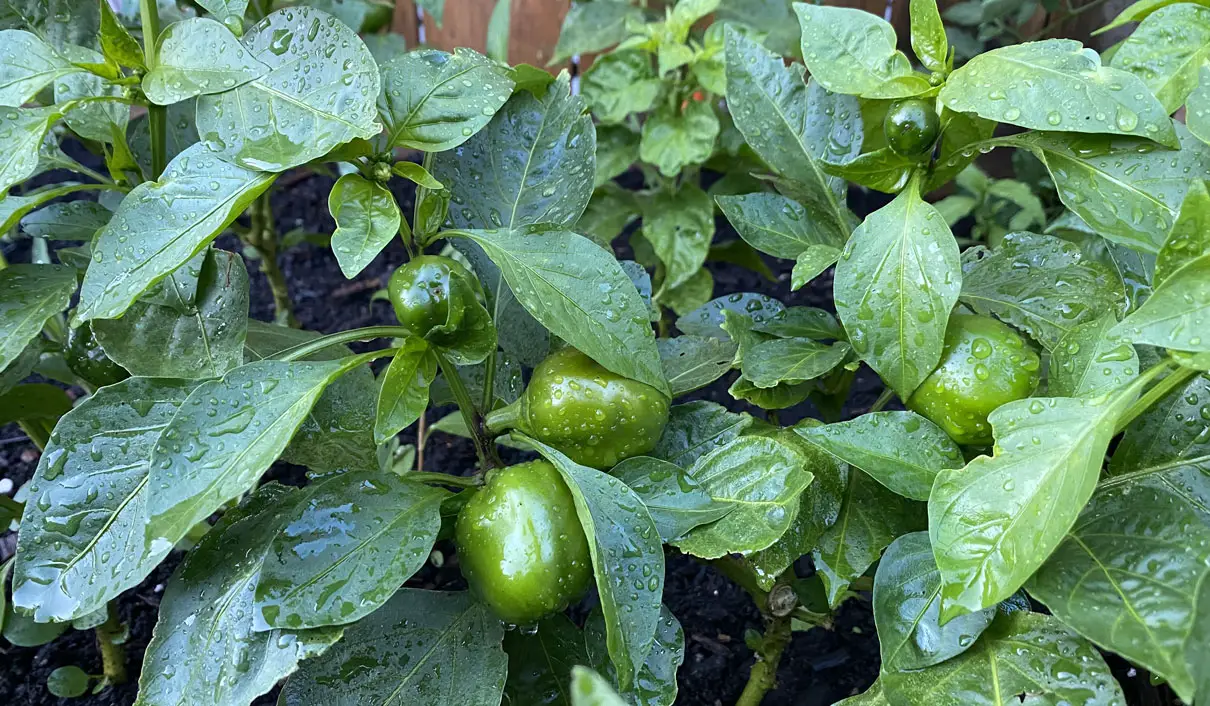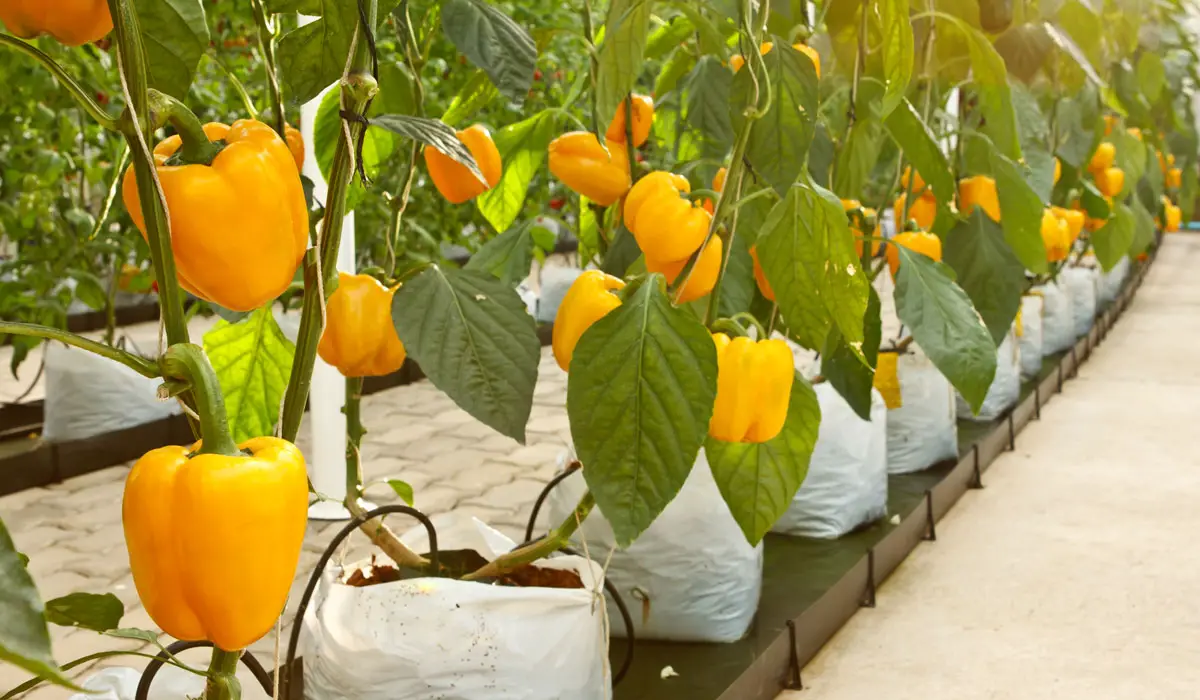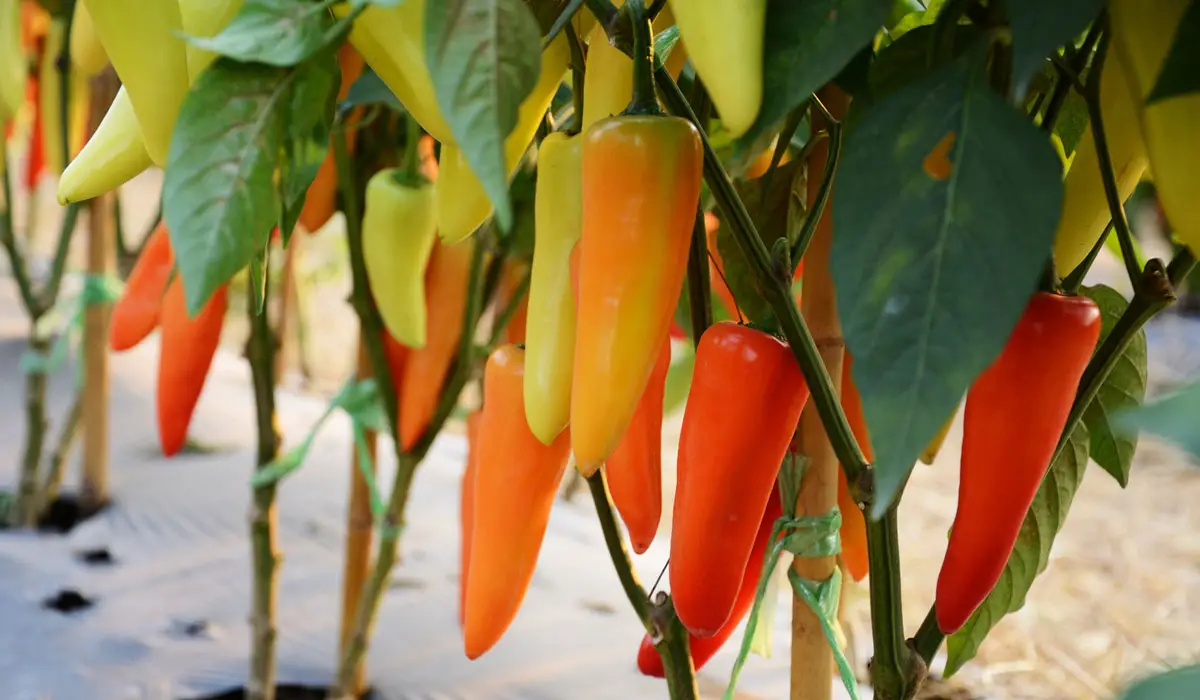The Trick to Growing Hydroponic Peppers at Home

This post follows our research editorial guidelines.

Nothing compares to the satisfaction of growing fiery peppers all year round, even with the Canadian winter begging for blood at my door. They’re excellent candidates for hydroponics, and my Aerogarden peppers bring the best of heirloom varieties straight to my table no matter the weather. Pepper fans have put a lot of information out there for new growers, but while that overload might be intimidating it’s really not that hard to get started.

Table of Contents
Do peppers grow well in hydroponics?
Pepper grow well in almost all hydroponics systems. They are well suited for smaller domestic Deep Water Culture setups to more complex setups. With a bit of care, they will fruit continuously and provide a steady stream of peppers year-round.
The Secret to Best Hydroponic Peppers
The secret to growing good hydroponic peppers at home is simply that it isn’t that hard at all! Sweet peppers and spicy alike need far less fussing than you’d think from all the banter online about their care.
They have moderate nutritional needs, they’re happily share their space with compatible crops like herbs and they don’t need special light period or chill temperatures to set flower or fruit.
Peppers also do well in just about every hydroponic system you can imagine. They thrive in Deep Water Culture systems like the Aerogarden and other commercial setups, and even a home made Kratky system will work just fine with a bit of effort.
Starting peppers seeds hydroponically
You will need:
- Pepper seeds
- Growing medium
- Propagation tray with clean lid
- Clean water
- Grow light (optional)
- Heat mat (optional)
1. Choose a growing medium
Before you can get growing, you have to make some decisions about your growing medium.
Seed plugs are a good starting point for Deep Water, Nutrient Film and the like. They are made from rockwool, Oasis or even natural materials like coco coir or peat, often with a small hole ready to receive your seeds.
If you’re using a bedded system, you’re better off germinating in a coir based seed starter, or even just plain coir or peat.
2. Soak the growing medium and prepare the pods
Soak your chosen medium with pure water until it’s moist but not sodden. If growing in a loose medium, put it in your propagation tray to a depth of three or four inches.
3. Plant seeds and space accordingly
Plant your seeds to a depth of a quarter inch, two or three seeds per grow cube. For a loose medium, plant at the same depth in greater numbers than you need. Once sprouted, you can thin them out discard any weak seedlings.
Close the lid of the propagation tray and place in a warm, well-lit location like a window sill or under a grow light.
Peppers are able to grow much closer than their counter nightshades, I typically place each plant within it’s own square foot section and get some great results.
4. Keep seeds warm
Keep your seeds warm, ideally at soil temperature of 70°F (21°C).A heat mat beneath the seeds kept between 80 – 90°F (26-32°C) will really get them sprouting. They should pop up after 8 to 12 weeks.
Water well, keeping the growing medium moist. For seeds germinating in cubes, a little pure water at the base of the tray will keep the blocks moist without drowning the seeds.
5. Transplant or thin out
Once the seedlings are around 1 month old, they can be relocated to your hydroponic system. Cubes can be tucked into baskets, and for bedded systems planted neatly into buckets or beds.
If you’re using a “done-for you” system like an AeroGarden to grow your peppers there is no need to transplant. Instead keep the seed pods in place and thin out the seedlings so there is only 1 seedling per pod.
Starting with peppers cutting hydroponically

You can grow peppers quite easily from a cutting, making the process faster and more reliable.
You will need:
- A mature pepper plant
- Sterile shears or garden scissors
- A clear vessel of water – an old jar is a sustainable choice
1. Choose your cutting
Locate a new, leafy shoot with at least two to four leaves. Make it’s from the end of the plnt, and that there’s two inches of clearance at the base.
The best time to take cuttings is before flowering, as a plant that’s got blossoms isn’t going to root readily and even ones that do tend to be small and unlikely to grow much at all.
2. Water
Pop your cutting in its vessel of water, and place it in a well-lit area. A south eastern facing windowsill is ideal, but close proximity to grow lights works fine too.
If you’re using something like an Aerogarden you can cut to the chase and just pot it straight in a clean grow pod and place directly into the system. Depending on the size of the pepper plant you may want to discard the growing medium to make some space.
3. Keep the cutting well-lit and warm
Peppers don’t take long at all to set root. In ideal conditions you may only be waiting a few weeks for the roots to come in. In the meantime, keep the leaves well-lit and warm. Avoid direct light on the vessel, however, as this can overheat the water and kill the emerging roots.
4. Transplant
Once the roots are between four and six inches, you can transplant to your hydroponic system.
Best Dwarf peppers for hydroponics
For compact systems, you need a compact dwarf pepper! Most grow no more than a foot or two even without pruning, making them ideal for small setups.
Jingle Bell
As festive in person as they sound, these are a sweet bell pepper that grows around a foot or so tall. Their small sweet fruit is ideal for sandwiches or salads, and can be harvested when green or red.
Mirasol
For a classic Mexican touch, this heirloom variety produces a classic scarlet pepper. They’re spicy as a jalepeño, with a sweet fruity taste. Plants reach two feet, but can be carefully pruned smaller without too much fuss.
NuMex Twilight
Originally developed by the New Mexico State University as an ornamental, this beauty produces small purple chilies that turn yellow, then orange and finally red as they ripen. Don’t be deceived by their pretty face – they can top at out 50 000 Scovilles, roughly the same heat as Tabasco sauce.
Demon Red
If you want some true fire from your setup, the tiny Thai pepper Demon Red delivers. These vibrant red peppers are between one and three inches long and pack a real punch, with some very dedicated growers getting 200 000 Scovilles from their crops.
Best hot peppers for hydroponics
Jalapeño Summer Heat
Jalapeños are a classic, a perfect blend of sweet and spicy. The Summer Heat cultivar is particularly well suited for hydro setup. They produce full size fruit despite being a compact plant that only reaches around three feet. Do be wary of pests, as they’re a bit more vulnerable than most.
Hungarian Wax Pepper

Ideal for pickling or canning, the Hungarian Wax Pepper is a versatile heirloom variety. It produces long, bright fruit, that when picked yellow contain a mild 1 000 Scovilles. Let them ripen to red, and you might get hit with 15 000 instead!
Prairie Fire
This foot high fireball produces dainty fruit small enough to pop in your mouth whole, though you’d want to be careful. They produce some astonishingly hot chillies, reaching 80 000 Scovilles but with a real fruity flavour that delights those of us who love a forceful flavor.
Naga Jolokia
Surprisingly, the world’s most terrifying peppers often grow beautifully in hydroponics. This includes the Nagas, known more readily as the Ghost Peppers. With effort, these beasts top out at over a million Scovilles. They’re often grown in standalone Kratky setups, to better manage their specific wants and desires.
Best Sweet peppers for hydroponics
Doe Hill (heirloom)

Doe Hill Peppers are one of my favorites. They produce small, unbelievably sweet fruit that matures into either a yellow or orange fruit. They’re a compact grower with thick walls, reaching two feet or thereabouts. When grown with the proper mix of NPK they develop a distinct cotton candy flavor. Beware though, if you’re growing these outdoors they are also loved by pepper flies for their sweet fruit.
Ace (F1)
This tough variety has a lot going for it for the home grower. Ace is tolerant of cooler temperatures and is resistant to Blossom End Rot while still reaching a decent three or four feet. It fruits heavily, producing crisp medium sized fruit.
California Wonder

Another heirloom vine, the California Wonder fruits more the more frequently you harvest. The peppers are large and lush, good for eating raw or for cooking. It’s another larger plant, edging up towards three feet.
Yolo Wonder
Tough and hardy, the Yolo is a two-to-three-foot variety that produces good sized fruit. The fruit is about four inches long, thick walled and good for a variety of uses. It’s more disease and pest resistant than most, so a good choice for first time growers.
What hydroponic system is best for peppers?
Peppers really do thrive in just about any hydroponics setup, so the question is more what system is best for you. If you want smaller, hotter chilies, close to the kitchen itself, a small scale system like an AeroGarden hosting a dwarf plant is perfect. For larger chilies DWC or drip systems work well.
Light

Peppers love light, and will reward you if you indulge them. While they’ll plod along in 6-8 hours of good bright light, aim for 12-16 hour intervals for maximum production.
It’s well documented that the more light they get, the better the fruit, so if you’re growing indoors don’t be stingy with the grow-light.
“The most important factor in growing chiles is light. Just to survive they need at least six hours of bright sunlight a day (southern exposure is best for this) and about eight hours of indirect light (from eastern or western exposure). If you are growing peppers on a windowsill and they appear to be just hanging on, supplement their natural light with artificial light.”
Susan Belsinger, culinary herbalist, educator at Brooklyn Botanic Gardens
Water
Peppers of all types thrive in water that has a pH of between 5.5 and 6.0. While they’ll do just fine at more alkaline conditions, it puts you at risk of root disease.
Growing medium
Peppers will really grow in just about anything. So long as it holds water and nutrients you’re good to go.
I like using clay pebbles to grow my peppers. They’re great for NFT setups and are infinitely re-usable, so I’m never short of supplies when the time comes to plant.
Nutrients
Peppers are heavy feeders, with different needs as the season progresses. Nitrogen is important during early stages of growth, but you’ll need to move to a potassium rich blend to ensure good fruiting.
They need an EC of around 0.8 to 1.8, and watch your calcium and magnesium. Poor uptake can lead to blossom end rot, so it’s often worth adding a bit of Calmag in the lead up to flowering.
Pollination
It’s blessedly easy to pollinate peppers. Just shake the branches once the flowers are ready, every morning until you see fruit. The pollen will loosen up and the flower will self-fertilize. You can also opt to pop a fan nearby to achieve much the same thing.
If you really want to be sure, AeroGarden make a “bee wand” that pollinates in a way similar to insects. For the thrifty, an electric toothbrush will achieve much the same thing.
Pruning
Unlike tomatoes, peppers don’t produce lateral buds. It’s best to pinch off the very top leaves in order to encourage thicker growth. Prune to encourage side branches, you’ll see more fruit.
Start when the plant reaches 6 inches or so (15cm). Pinch off the top cluster of leaves with sterile shears, though personally I find those tender shoots will give way to fingernails alone. The vine will fork, and as each new offshoot grows prune away any new forks as they develop. This gives a compact plant with lots of flower buds.
Spacing
Peppers don’t mind a bit of close company. Grow them at a spacing of one per square foot or thereabouts, double if you’ve opted for dwarf varieties.
If you’re using a commercial system with pre-cut holes, you can fill the gaps with shorter crops that share similar needs. Basil my go-to, but bok choi is a nice option too if you fancy a spicy stir fry further down the track!
As they grow larger, peppers need to be supported. For dwarf crops, canes or stakes will get the job done. Larger plants in bedded systems will need more help, and wire trellises or tomato cages are a good option.
Temperature
Peppers love a bit of warmth to really get going. Try to keep them between 70-80°F (21-26°C). Much higher than that and you risk the plant dropping its blossoms.
Pests
Insect pests love peppers just as much as I do. Indoors they’re vulnerable to white fly, thrips, leaf miners and aphids, as well as caterpillars and other pests that rarely make it inside. You can treat them with standard commercial pesticides if need be, just be sure to avoid spraying developing fruit or flowers.
Diseases
The warm temperatures and neutral water pH make our peppers a real playground for root problems if not carefully managed. Phytophthora and Pythium are substantial hazards, so always practice good hygiene around your setup. While you can flush infected roots with a 3% hydrogen peroxide solution, stressed plants produce little to no fruit and it’s often best to just ditch the lot.
They’re also prone to bacterial leaf spot and anthracnose. Both of these are treatment resistant, so again you’ll just have to start over.
| Hydroponic Setup Requirements For Peppers | |
| Light | Min. 6 hours, 12-16 for maximum yield |
| Water | PH 5.5-6.0 |
| Growing Medium | Any |
| Nutrients | EC of 0.8-1.8, monitor calcium |
| Pruning | Pinch new shoots to encourage dense growth |
| Spacing | 1 per square foot, double for dwarf varieties |
| Temperature | 70-80°F (21-26°C) |
| Pests | White fly, thrips, leaf miners, aphids, beetles |
| Disease | Pythium, Phytopthora, bacterial leaf spot, anthracnose |
Final thoughts
Peppers are easy to start growing and easy to fall in love with. It doesn’t take much to move from straightforward AeroGarden peppers onwards to growing sweet heirloom varieties or trying to get that deadly fire from a high Scoville beast like a Ghost Pepper or a Carolina Reaper. There’s always a new adventure, no matter how comfortable you are growing these wonderful and versatile plants.

